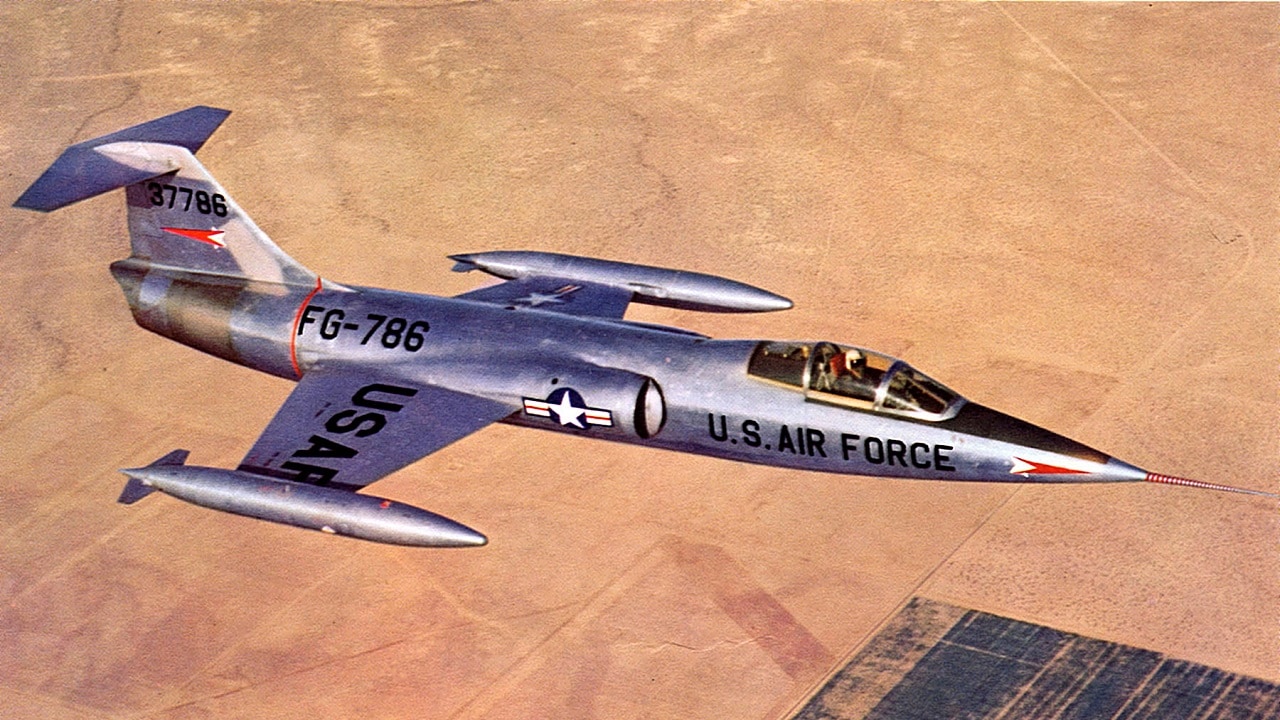The Lockheed F-104 Starfighter was a Cold War era single-engine supersonic interceptor. Introduced to the US Air Force in 1958, the F-104 was a member of the “Century Series,” one that defied ongoing trends in the aerospace design community.
In the late 40s and early 50s, aerospace designers were in the habit of building their new planes larger and more complex than their last planes. Lockheed’s lead designer, Clarence “Kelly” Johnson, had a novel idea however; in 1951, Johnson toured South Korea, and spoke to fighter pilots, asking: what do you want in a fighter? The American pilots, who had spent the conflict engaged with small, simple MiG-15s, felt that the US’s F-86 Sabre was inferior – despite being larger and more complex. The pilots asked Johnson for something small, something simple, something that could fly high and fly fast. Johnson listened; returning to Skunk Works, Johnson eschewed the tendency to go bigger and more complicated. He set out to design a simple, lightweight aircraft that could fly high and fast – just like the pilots had requested.
To keep weight down, and complexity minimalized, Johnson’s team designed their new jet around a single-engine. But which engine? To give the new jet adequate performance, that one engine would have to deliver. Accordingly, the team selected the General Electric J79 turbojet, which was significantly more advanced than contemporary engines, and entirely capable of propelling the (just) 12,000 pound airframe.
The lightweight airframe was constructed from an aluminum alloy named duralumin (with some stainless steel and titanium mixed in). The finished product was long and narrow, with a fuselage nearly two hundred and fifty percent longer than the wingspan. The wings were notable. Unlike most contemporary aircraft designs, which used swept-wing or delta-wings, the F-104 featured a small, thin, straight, mid-mounted trapezoidal wing. The wing’s leading edge was swept backwards, 26 degrees; the wing’s trailing edge was swept forward, less dramatically. The short stubby wings, set against a long, sleek fuselage gave the F-104 a rocket-like appearance.
Indeed, sometimes the F-104 behaved like a rocket. Initially, the F-104’s landing speed was so high that Lockheed needed to design a boundary layer control system (BLCS) that blew high-pressure bleed air over the trailing-edge flaps in order to lower landing speeds (to about 185 miles per hour). Engaging the BLCS, and hence lowering landing speeds, required lifting the flaps for landing. While flaps are typically used on landings, doing so was especially important in an F-104: flapless landings were only permitted in emergencies. And like a rocket, the Starfighter had excellent speed, acceleration and climb rate – but it turned like a school bus.
While the F-104 was designed for air-superiority missions, the US Air Force were in need of a supersonic interceptor (as their upcoming interceptors, the F-102 Delta Dagger and F-106 Delta Dart were experiencing production delays). The F-104, with its Mach 2 max speed and 48,000 feet per minute rate of climb, fit the bill and was slotted as an interim interceptor.
The F-104 was not safe. Export customers, like West Germany, Belgium, Italy, and Canada experienced staggering accident rates, losing 32, 41, 37, and 46 percent of their Starfighter fleets respectively to accidents. With the USAF, the Starfighter was lost at a rate of 25.2 aircrafts destroyed per 100,000 flight hours. By comparison, other jets in the Century Series were lost at rates between 7.3 and 16.2 planes per 100,000 flight hours. The F-104’s spotty safety record is immortalized, in The Right Stuff, when Chuck Yeager crashes his NF-104 (a rocket-modified F-104) during the film’s climactic scene.
Harrison Kass is the Senior Defense Editor at 19FortyFive. An attorney, pilot, guitarist, and minor pro hockey player, he joined the US Air Force as a Pilot Trainee but was medically discharged. Harrison has degrees from Lake Forest College, the University of Oregon, and New York University. He lives in Oregon and listens to Dokken. Follow him on Twitter @harrison_kass.

